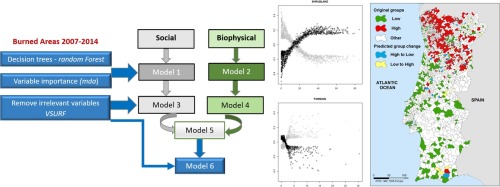当前位置:
X-MOL 学术
›
J. Environ. Manag.
›
论文详情
Our official English website, www.x-mol.net, welcomes your
feedback! (Note: you will need to create a separate account there.)
Assessing the biophysical and social drivers of burned area distribution at the local scale.
Journal of Environmental Management ( IF 8.0 ) Pub Date : 2020-03-26 , DOI: 10.1016/j.jenvman.2020.110449 Sandra Oliveira , José Luís Zêzere
Journal of Environmental Management ( IF 8.0 ) Pub Date : 2020-03-26 , DOI: 10.1016/j.jenvman.2020.110449 Sandra Oliveira , José Luís Zêzere

|
Understanding the characteristics of wildfire-affected communities and the importance of particular factors of different dimensions, is paramount to improve prevention and mitigation strategies, tailored to people's needs and abilities. In this study, we explored different combinations of biophysical and social factors to characterize wildfire-affected areas in Portugal. By means of machine-learning methods based on classification trees, we assessed the predictive ability of various models to discriminate different levels of wildfire incidence at the local scale. The model with the best performance included a reduced set of both biophysical and social variables and we found that, oveall, the exclusion of specific variables improved prediction rates of group classification. The most important variables were related to landcover; the civil parishes covered by more than 20% of shrublands were more fire-prone, whereas those parishes with at least 40% of agricultural land were less affected by wildfires. Regarding social variables, the most-affected parishes showed a lower proportion of foreign residents and lower purchasing power, conditions likely associated with the socioeconomic context of inland low-density rural areas, where rural abandonment, depopulation and ageing trends have been observed in the last decades. Further research is needed to investigate how other particular parameters representing the social context, and its evolution, can be integrated in wildfire occurrence modelling, and how these interact with the biophysical conditions over time.
中文翻译:

评估当地烧伤地区分布的生物物理和社会驱动因素。
了解受野火影响的社区的特征以及不同维度的特定因素的重要性,对于改进针对人们需求和能力的预防和缓解策略至关重要。在这项研究中,我们探索了生物物理和社会因素的不同组合,以描绘葡萄牙受野火影响的地区。通过基于分类树的机器学习方法,我们评估了各种模型在本地规模上区分不同级别的野火发生率的预测能力。具有最佳性能的模型包括一组减少的生物物理变量和社会变量,并且我们发现,总体而言,排除特定变量可以提高组分类的预测率。最重要的变量与土地覆盖有关。有超过20%灌木丛覆盖的民间教区更容易发生火灾,而农业用地至少占40%的教区受到野火的影响较小。关于社会变量,受影响最严重的教区显示外国居民比例较低,购买力较低,这可能与内陆低密度农村地区的社会经济背景有关,最近一次观察到农村地区的人口荒废,人口减少和老龄化趋势几十年。需要进行进一步的研究,以研究代表社会情境的其他特定参数及其演变如何整合到野火发生模型中,以及随着时间的推移它们如何与生物物理条件相互作用。而拥有至少40%农业土地的教区受野火的影响较小。关于社会变量,受影响最严重的教区显示外国居民比例较低,购买力较低,这可能与内陆低密度农村地区的社会经济背景有关,最近一次观察到农村地区的人口荒废,人口减少和老龄化趋势几十年。需要进行进一步的研究,以研究代表社会情境的其他特定参数及其演变如何整合到野火发生模型中,以及随着时间的推移它们如何与生物物理条件相互作用。而拥有至少40%农业土地的教区受野火的影响较小。关于社会变量,受影响最严重的教区显示外国居民比例较低,购买力较低,这可能与内陆低密度农村地区的社会经济背景有关,最近一次观察到农村地区的人口荒废,人口减少和老龄化趋势几十年。需要进行进一步的研究,以研究代表社会情境的其他特定参数及其演变如何整合到野火发生模型中,以及随着时间的推移它们如何与生物物理条件相互作用。内陆低密度农村地区的社会经济环境可能造成的不利条件,在过去的几十年中,农村地区出现了人口荒废,人口减少和老龄化的趋势。需要进行进一步的研究,以研究代表社会情境的其他特定参数及其演变如何整合到野火发生模型中,以及随着时间的推移它们如何与生物物理条件相互作用。内陆低密度农村地区的社会经济环境可能造成的不利条件,在过去的几十年中,农村地区出现了人口荒废,人口减少和老龄化的趋势。需要进行进一步的研究,以研究代表社会情境的其他特定参数及其演变如何整合到野火发生模型中,以及随着时间的推移它们如何与生物物理条件相互作用。
更新日期:2020-03-27
中文翻译:

评估当地烧伤地区分布的生物物理和社会驱动因素。
了解受野火影响的社区的特征以及不同维度的特定因素的重要性,对于改进针对人们需求和能力的预防和缓解策略至关重要。在这项研究中,我们探索了生物物理和社会因素的不同组合,以描绘葡萄牙受野火影响的地区。通过基于分类树的机器学习方法,我们评估了各种模型在本地规模上区分不同级别的野火发生率的预测能力。具有最佳性能的模型包括一组减少的生物物理变量和社会变量,并且我们发现,总体而言,排除特定变量可以提高组分类的预测率。最重要的变量与土地覆盖有关。有超过20%灌木丛覆盖的民间教区更容易发生火灾,而农业用地至少占40%的教区受到野火的影响较小。关于社会变量,受影响最严重的教区显示外国居民比例较低,购买力较低,这可能与内陆低密度农村地区的社会经济背景有关,最近一次观察到农村地区的人口荒废,人口减少和老龄化趋势几十年。需要进行进一步的研究,以研究代表社会情境的其他特定参数及其演变如何整合到野火发生模型中,以及随着时间的推移它们如何与生物物理条件相互作用。而拥有至少40%农业土地的教区受野火的影响较小。关于社会变量,受影响最严重的教区显示外国居民比例较低,购买力较低,这可能与内陆低密度农村地区的社会经济背景有关,最近一次观察到农村地区的人口荒废,人口减少和老龄化趋势几十年。需要进行进一步的研究,以研究代表社会情境的其他特定参数及其演变如何整合到野火发生模型中,以及随着时间的推移它们如何与生物物理条件相互作用。而拥有至少40%农业土地的教区受野火的影响较小。关于社会变量,受影响最严重的教区显示外国居民比例较低,购买力较低,这可能与内陆低密度农村地区的社会经济背景有关,最近一次观察到农村地区的人口荒废,人口减少和老龄化趋势几十年。需要进行进一步的研究,以研究代表社会情境的其他特定参数及其演变如何整合到野火发生模型中,以及随着时间的推移它们如何与生物物理条件相互作用。内陆低密度农村地区的社会经济环境可能造成的不利条件,在过去的几十年中,农村地区出现了人口荒废,人口减少和老龄化的趋势。需要进行进一步的研究,以研究代表社会情境的其他特定参数及其演变如何整合到野火发生模型中,以及随着时间的推移它们如何与生物物理条件相互作用。内陆低密度农村地区的社会经济环境可能造成的不利条件,在过去的几十年中,农村地区出现了人口荒废,人口减少和老龄化的趋势。需要进行进一步的研究,以研究代表社会情境的其他特定参数及其演变如何整合到野火发生模型中,以及随着时间的推移它们如何与生物物理条件相互作用。











































 京公网安备 11010802027423号
京公网安备 11010802027423号